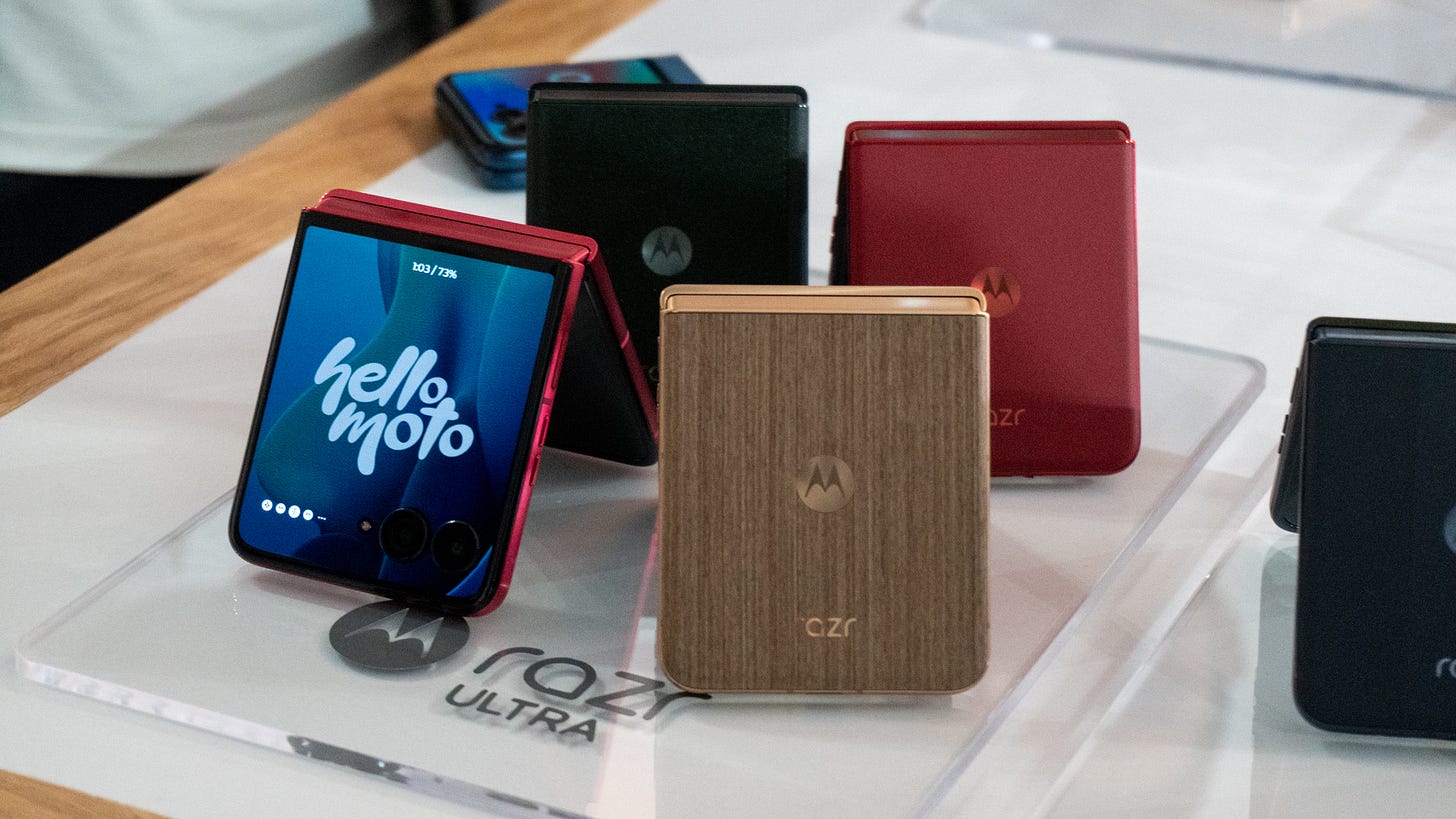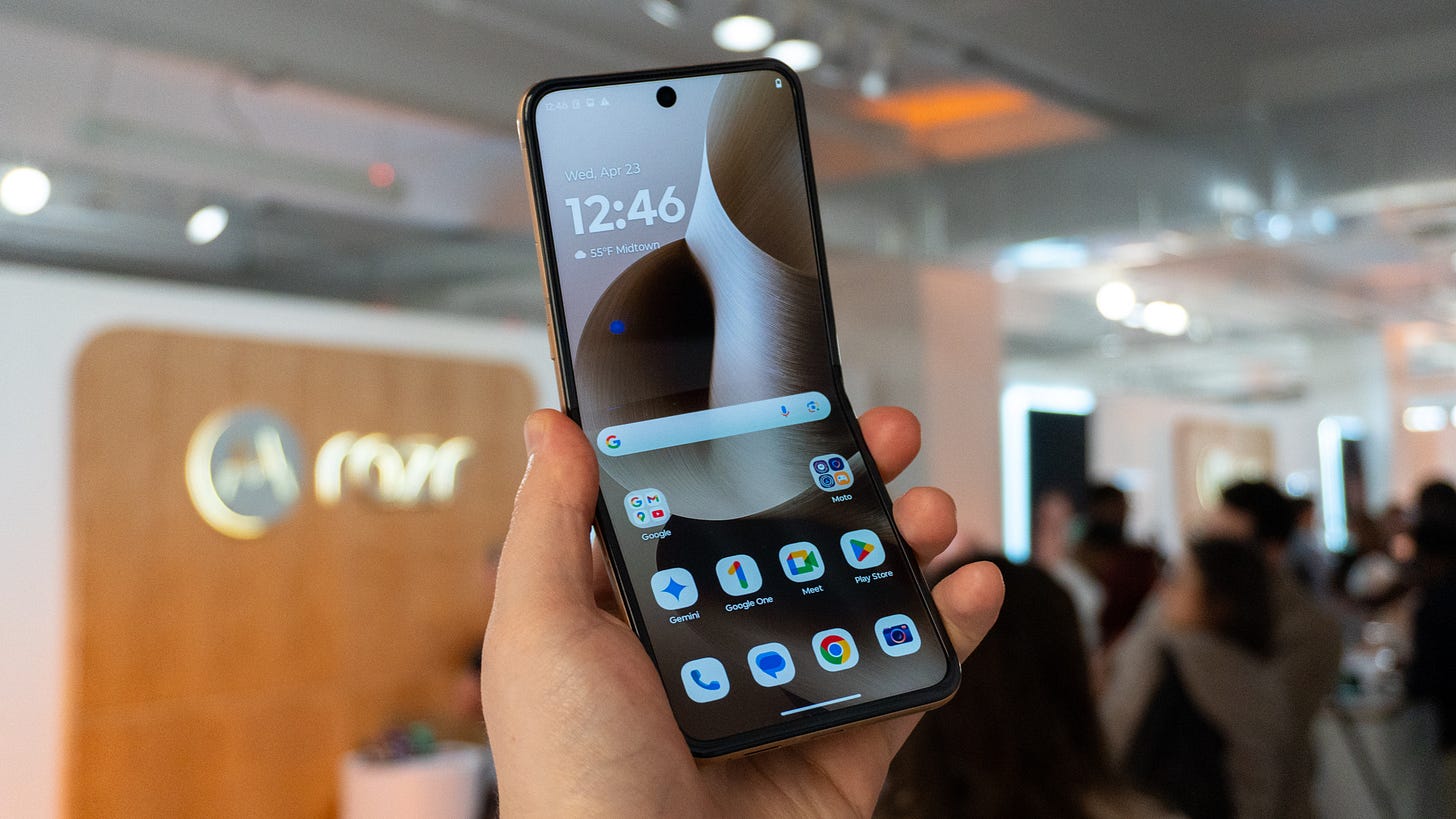Motorola Razr Ultra hands-on review: better cameras and AI for $1,300
Motorola's latest Razr phone promises a more premium flip-phone experience – and for a premium price
🤳 I went hands-on with Motorola’s newest Razr phones for 2025
👀 The Razr Ultra is the most interesting – and the most expensive
📸 It comes with upgraded cameras, a similar design to older Razrs, a bigger battery, and a $1,300 price tag
📱 The new Razr Plus and Razr offer minor spec bumps compared to 2024
📅 All three phones will go on sale next month around the world
Motorola invited a group of reporters to midtown Manhattan to unveil the latest Razr phones, and the only question on my mind is whether you can truly justify a $1,300 flip phone in 2025.
That’s how much the company’s Razr Ultra costs. The highest-end model in Moto’s new trio of Razr phones, the Razr Ultra promises to deliver a premium foldable experience at a premium price. It looks virtually identical to the Razr Plus (save for fancier finishes) and focuses on better specs to improve the experience. Meanwhile, the regular Razr Plus and Razr have even smaller durability and faster performance upgrades compared to the Moto Razr (2024).
As the Samsung Galaxy Z Flip 7 quickly approaches, Motorola’s latest flip phones seem ready for the competition. While the upgrades year-over-year aren’t substantial, these seem like rock-solid foldables, at least at first glance.
Hands-on with the Moto Razr Ultra, Razr Plus, and Razr (2025)
A lot of AI
👥 Partnering with… everyone. Motorola is working with a lot of companies to make its AI features happen on the new Razrs, from Google to Meta to Microsoft for Copilot integration. Perhaps the biggest new addition is Perplexity, which comes pre-installed on every new Razr phone and makes it easier to research complex topics. Moto is also picking and choosing which models it uses to power certain features – some rely on Meta’s Llama, while others use Gemini. It’s a smorgasbord of AI integrations, all to power Moto AI.
🤖 Moto AI seems very intriguing. Altogether, Motorola’s take on AI seems pretty interesting. The company has a lot of features it hopes will entice people to buy its phones instead of Samsung’s, such as Catch Me Up (for going over your missed notifications quickly) and Remember This (for remembering specific information in screenshots, photos, and more). There’s also Next Move that recognizes content like recipes and suggests next steps, Image Studio for generating images, and Playlist Studio for AI-created playlists based on your preferences. I didn’t get to spend a lot of time playing with these features, but I can see how they’d make sense in everyday life. Plus, they live alongside Perplexity and Gemini, so your AI options are practically endless.
🔘 Press and hold. The Moto Razr Ultra makes accessing AI a bit easier with a dedicated key on the side. Press and hold it to access Moto AI and the features associated with it. I didn’t get clarification as to whether the AI Key is re-programmable, but I’ll update this article if/when I find out.
How “Ultra” is the Ultra?
👀 Familiar face with a stronger build. The Moto Razr Ultra looks a lot like the Razr Plus from last year. It has the same 4-inch cover screen and a slightly larger 7-inch folding display, complete with thinner bezels. The big difference is the durability of the phone; it has a reinforced titanium hinge that’s four times stronger than stainless steel and can withstand up to 35% more folds than before. The Ultra Thin Glass on the folding screen is also stronger than before, which results in a shallower crease. There’s also IP48 certification, which includes dust and dirt resistance (the first time for any Razr phone). It’s a tough little sucker, and the big test will be long-term use. Stay tuned.
🌈 Fresh colors with fresh finishes. Motorola partnered with Pantone on all of its new Razr colors this year. For the Razr Ultra, there’s Rio Red, Scarab, Mountain Trail, and Cabaret. The more interesting aspects of the colors is the material used, with colors offering a variety of materials from Alcantara to real wood grain. These finishes looked and felt premium in person, especially the wood.
📸 Big camera improvements. Another upgrade Motorola gave the Razr Ultra are what the company calls “the world’s most advanced” camera system on a flip phone. There's a 50MP main camera paired with a 50MP 122-degree ultra-wide, plus a 50MP selfie camera. Together, Motorola says you’ll get much better photos and videos in a variety of lighting conditions. Moto doesn’t historically impress us with camera quality, so I’m not sure whether it can this time around.

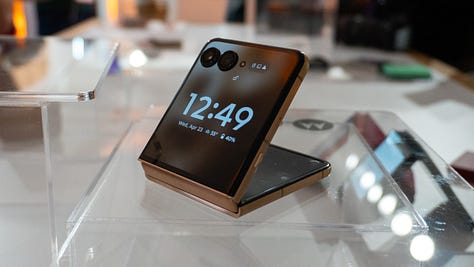

🌅 Plenty of camera features to test. Beyond quality, the Razr Ultra (as well as the other two Razrs) come with special features we’ll be trialing during our review period. This includes Group Shot, which can merge multiple group photos into one to ensure no one’s blinking or looking away. There’s also Action Shot for keeping fast-moving subjects in focus, Air Gestures for controlling your camera hands-free, and the new Photo Enhancement Engine that uses AI to adjust all your photos to the way you like automatically.
🏎️ A 2025 performance boost. Under the hood, the Razr Ultra ships with the Snapdragon 8 Elite processor and a whopping 16GB of RAM. You can pick between 512GB of storage or 1TB of storage, which will ensure this phone maintains speedy performance. I played with the Razr Ultra during my hands-on and the phone felt very responsive, so I’m looking forward to putting it through its paces when I get my review unit.
🔋 Bigger battery, much faster charging. If you’re like me and have been waiting for a flip phone with a big battery, the Razr Ultra is right up your alley. Motorola includes a 4,700mAh cell in this device, the biggest I’ve ever seen in a flip phone ever. What’s more, it comes with super-fast 68W wired charging, plus 30W wireless charging. You also get reverse wireless charging, convenient for juicing up your earbuds on the go.


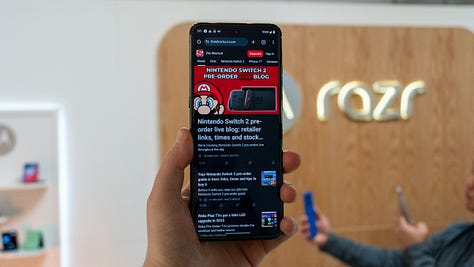
📱 The screens look gorgeous – especially the crease. I really enjoyed how the screens looked on the Razr Ultra during my hands-on. Motorola includes two high-quality OLED panels with sharp resolutions and 4,500 nits of brightness on the folding screen. They’re colorful, full of contrast, and feel very responsive with their 165Hz refresh rates. Plus, the reduced crease in the middle is a nice touch; you can still see it and feel it, but it’s definitely better than what last year’s Razr Plus came with.
📺 The cover display is still killer. Of course, using the cover screen is as great as ever. Samsung still hasn’t caught up to what Motorola is doing with its edge-to-edge cover panel, and the Z Flip 7 isn’t expected to change that. You still get useful widget panels, access to any app you want, and a big keyboard for responding to messages on the fly.
💰 $1,300 seems… high. My first impressions of the Razr Ultra are positive, except for the price. Motorola is making a lot of promises with this phone, and while I’m excited to test all of its upgrades, I’m skeptical the experience will hold up to its $1,299.99 price. I’ll explore this more in my full review, coming soon.
The Razr and Razr Plus are technically better
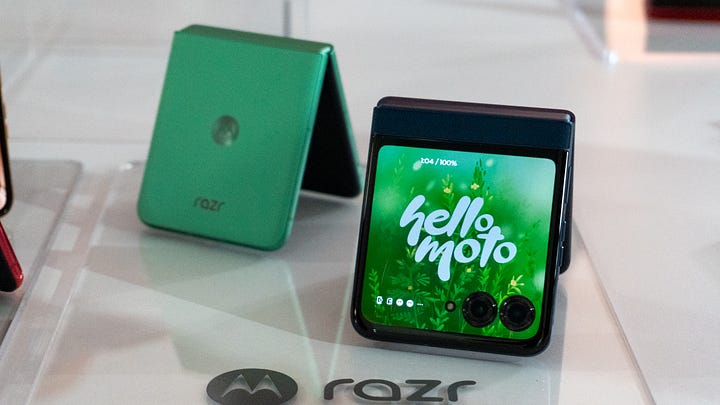

📱 Same designs, better durability. You’d be hard pressed to tell the Razr Plus or Razr from their predecessors on the outside. Motorola is maintaining the same designs as 2024, maintaining the same 4-inch cover screen on the Plus and 3.6-inch screen on the regular Razr. Both phones offer 6.9-inch folding screens with reduced creases thanks to the same durability benefits as the Razr Ultra, plus IP48 certification. I played around with these phones a lot, and the only difference is the new Pantone colors that Motorola is offering, which are quite nice in person.
🏎️ Performance and battery life get improvements. Both of these phones have faster chips. The Razr Plus gets the Snapdragon 8s Gen 3, while the regular Razr has a Dimensity 7400X. Each offers faster performance than their predecessors and 256GB of storage, while the Plus gets 12GB of RAM and the Razr has 8GB. You also get a bigger 4,500mAh battery on the regular Razr than last year, but the Plus sticks with the same 4,000mAh. Meanwhile, charging sits at 45W for the Plus and 30W for the Razr.
📸 Similar camera hardware. As of now, it doesn’t seems like photo quality will get a big boost on the new Razr and Razr Plus compared to last year, but I could be wrong. Motorola includes similar camera setups to last year with a 50MP main camera on both, a 13MP ultra-wide on the Razr, and a 50MP telephoto on the Plus. You get a lot of the same features as the Razr Ultra, an improved processing algorithm, and some AI features thrown in the mix. I’ll have to test the cameras more to know for sure, but right now, it doesn’t seem like much is changing.

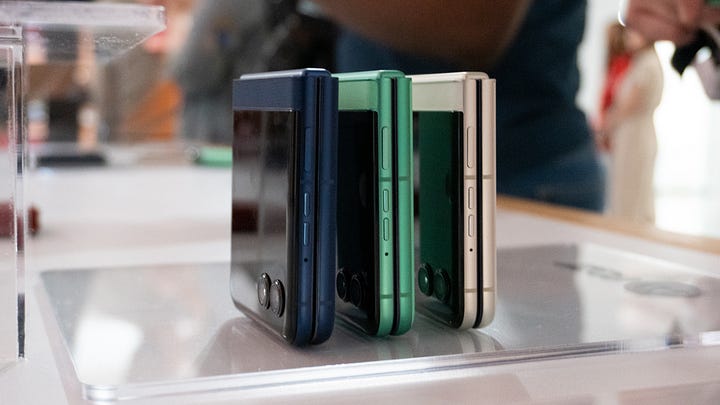
🤷 Yeah, they’re Razr phones. That’s sort of the vibe with the new Razr and Razr Plus. Motorola didn’t revamp these phones at all, and it seems perfectly fine with shipping similar phones to last year with a few spec improvements. All the emphasis is on the Razr Ultra, so these phones are taking a back seat this year.
💰 Same prices. Even the prices are staying the same. The regular Razr starts at $799.99 while the Razr Plus will cost $999.99. Full disclosure: these are good prices for folding phones of this caliber, and while it’d be nice to see them drop a bit, at least they didn’t go up.
Moto Razr 2025 release date
Motorola says the new Razr Ultra, Razr Plus, and Razr will be available for pre-order beginning on May 7. They’ll all go on sale May 15 at a variety of retailers, as well as carriers like T-Mobile and AT&T.
We have much more coverage on Motorola’s latest Razr phones in the pipeline, so be sure to subscribe so you don’t miss out.
Max Buondonno is an editor at The Shortcut. He’s been reporting on the latest consumer technology since 2015, with his work featured on CNN Underscored, ZDNET, How-To Geek, XDA, TheStreet, and more. Follow him on X @LegendaryScoop and Instagram @LegendaryScoop.



